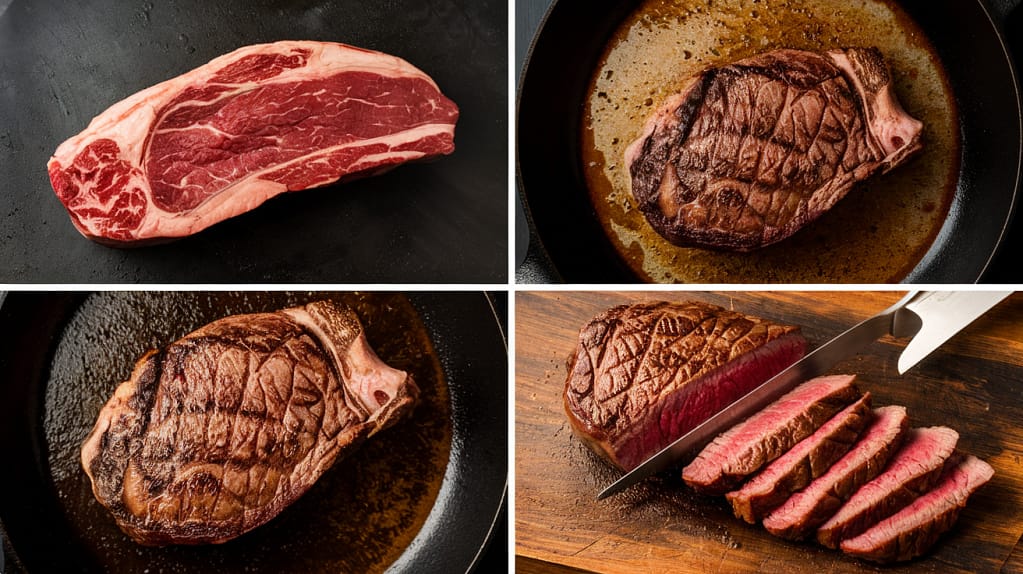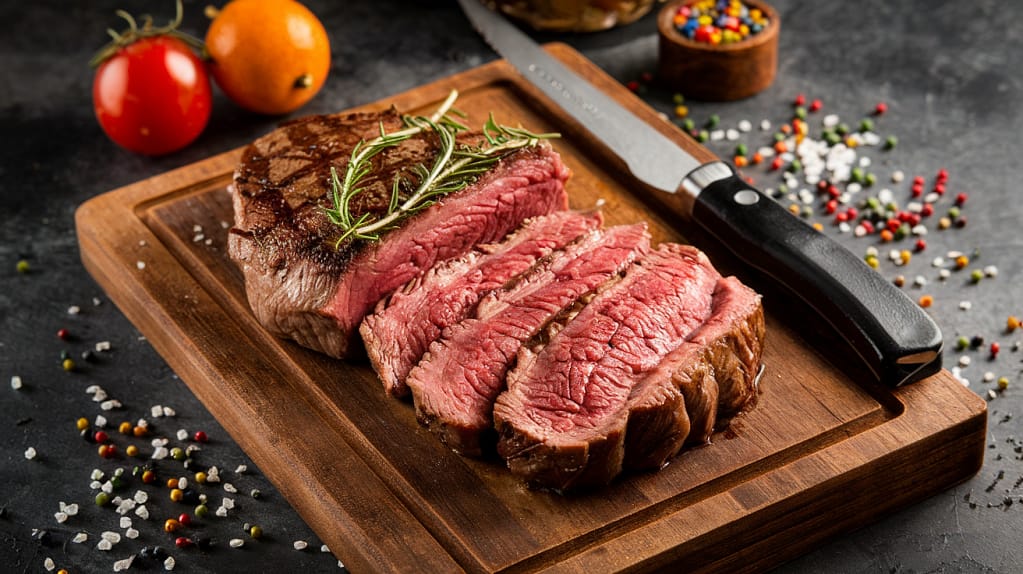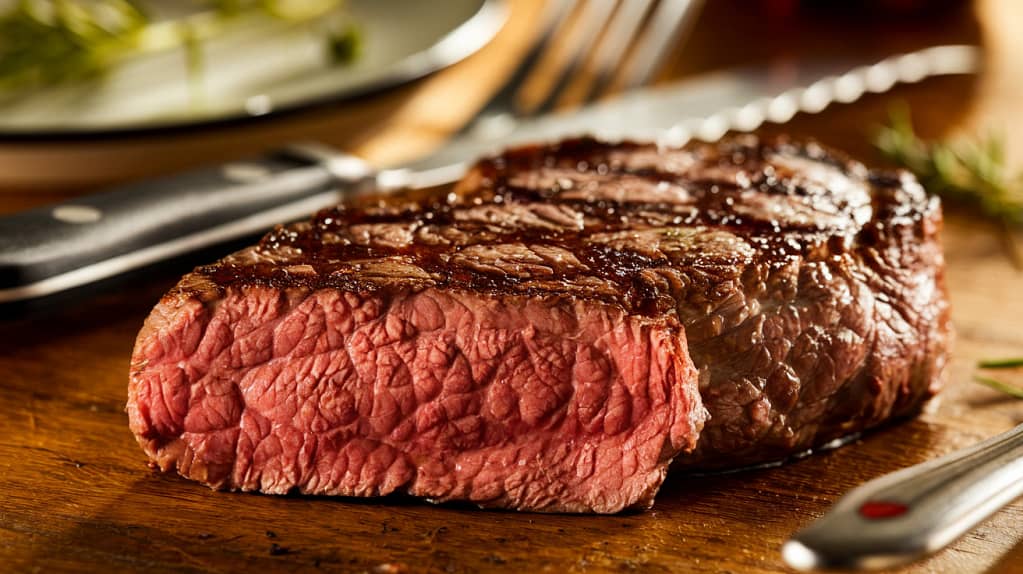Medium Rare Steak Temp: A Quick Guide
Did you know that 64% of professional chefs consider medium rare to be the optimal doneness for most premium steak cuts? Yet, achieving the perfect medium rare steak temp consistently remains elusive for many home cooks. Whether you’re grilling a ribeye for a special occasion or pan-searing a sirloin for a weeknight dinner, understanding the precise medium rare steak temp is crucial for that restaurant-quality result. The difference between a succulent, juicy steak and an overcooked disappointment often comes down to just a few degrees. In this comprehensive guide, we’ll demystify steak temperatures, with special focus on achieving that perfect medium rare steak temp every single time.
Table of Contents
Ingredients List
For the perfect medium rare steak, you’ll want to start with quality ingredients:

- 1-2 steaks (ribeye, New York strip, or filet mignon work best), 1-1.5 inches thick
- 2 tablespoons high-quality olive oil (or substitute with avocado oil for a higher smoke point)
- 2 teaspoons kosher salt (can substitute with sea salt flakes for a different texture)
- 1 teaspoon freshly ground black pepper (try multi-colored peppercorns for enhanced flavor)
- 2-3 garlic cloves, crushed (optional, can use garlic powder if fresh isn’t available)
- 2-3 sprigs of fresh rosemary or thyme (dried herbs can work in a pinch)
- 2 tablespoons unsalted butter (substitute with herb butter for extra flavor)
The aroma of butter melting into a perfectly seasoned steak, with the earthy scent of herbs and the robust fragrance of garlic, creates an irresistible sensory experience even before the first bite.
Timing
- Preparation Time: 10 minutes (includes seasoning and bringing the steak to room temperature)
- Cooking Time: 6-8 minutes (30% less time than well-done steaks, preserving more natural juices)
- Total Time: 25-30 minutes (including 15 minutes of essential resting time)
Achieving the perfect medium rare steak temp requires less overall cooking time than more well-done alternatives, making it not only the preferred choice for flavor but also a more time-efficient cooking option when properly executed.
Step-by-Step Instructions
Step 1: Prepare Your Steak
Remove your steak from the refrigerator 30-45 minutes before cooking. This crucial step allows the meat to come to room temperature, ensuring even cooking throughout. Pat the steak dry with paper towels to remove excess moisture, which is essential for achieving a beautiful sear. Season generously on all sides with salt and pepper, pressing the seasonings into the meat.
Step 2: Prepare Your Cooking Surface
Heat a cast-iron skillet or grill to high heat (approximately 450-500°F). The surface should be hot enough that a drop of water immediately sizzles and evaporates upon contact. For pan-searing, add a high smoke-point oil once the pan is hot, swirling to coat evenly. If you’re working with a non-stick surface, reduce the temperature slightly to prevent damage to the coating.
Step 3: Sear the Steak
Place your steak on the hot surface and let it cook undisturbed for 2-3 minutes. Resist the urge to move it around—this initial contact creates that coveted caramelized crust. Flip once and sear the other side for another 2 minutes. For thicker cuts, sear the edges by holding the steak with tongs and pressing each edge against the pan for about 30 seconds each.
Step 4: Monitor the Internal Steak Temp Medium
Here’s where precision matters most. For the perfect medium rare steak temp, you’re aiming for an internal temperature between 130-135°F (54-57°C). Use a digital meat thermometer inserted into the thickest part of the steak for an accurate reading. Remember that rare steak temp measures 120-125°F (49-52°C), while medium steak temp ranges from 135-145°F (57-63°C). The steak will continue cooking slightly after removal from heat.
Step 5: Rest Your Steak
Perhaps the most overlooked yet critical step: let your steak rest for 5-10 minutes on a cutting board, loosely tented with foil. This allows the juices to redistribute throughout the meat rather than spilling out when cut. During this rest period, the internal temperature will rise approximately 5°F, completing the cooking process to perfect medium rare doneness.

Nutritional Information
A 6-ounce medium rare steak typically provides:
- Calories: 350-420 (varies by cut and marbling)
- Protein: 35-42g (supplies approximately 75% of the daily recommended protein intake)
- Fat: 22-28g (primarily monounsaturated and saturated fats)
- Carbohydrates: 0g
- Iron: 15% of Daily Value (more bioavailable than plant-based sources)
- Zinc: 40% of Daily Value (essential for immune function)
- Vitamin B12: 70% of Daily Value (crucial for nerve function and blood health)
- Sodium: 125mg (before added salt)
Research indicates that medium rare cooking preserves up to 40% more B vitamins compared to well-done preparations, making it nutritionally advantageous when consuming red meat.
Healthier Alternatives for the Recipe
While a medium rare steak can be part of a balanced diet, consider these modifications for various dietary needs:
- Choose grass-fed beef, which typically contains up to 50% more omega-3 fatty acids than conventional beef
- Reduce portion size to 4-5 ounces and pair with vegetable sides for a balanced plate
- For those limiting red meat consumption, substitute with bison (25% lower in calories) or venison (significantly leaner)
- Use herb-infused olive oil instead of butter for basting to reduce saturated fat
- For low-sodium diets, use salt-free herb blends and citrus zest for flavor enhancement
- Pair with antioxidant-rich sides like sautéed greens or roasted vegetables to create a more balanced meal
Serving Suggestions
Transform your perfectly cooked medium rare steak into a memorable meal with these serving ideas:
- Slice thinly against the grain and serve atop a bed of arugula with shaved parmesan and balsamic glaze
- Create a steakhouse experience at home by pairing with a twice-baked potato and grilled asparagus
- For a summer feast, serve alongside grilled corn on the cob with herb butter and a fresh tomato salad
- Make it a date night special with a red wine reduction sauce, truffle mashed potatoes, and roasted brussels sprouts
- For brunch, top with a sunny-side-up egg and serve with breakfast potatoes for an indulgent steak and eggs
- Slice and serve on a wooden board with blue cheese crumbles, caramelized onions, and artisanal bread for casual entertaining

Common Mistakes to Avoid
Even experienced home chefs can fall prey to these steak-cooking pitfalls:
- Not using a thermometer: Visual cues alone are unreliable; studies show that even professional chefs improve consistency by 60% when using a meat thermometer for precise medium rare steak temp
- Cooking cold steak: Taking steak directly from refrigerator to heat creates temperature gradients that result in uneven cooking
- Frequent flipping: Flipping more than once disrupts the Maillard reaction responsible for developing flavor and texture
- Improper cutting technique: Cutting with rather than against the grain can make even perfectly cooked medium rare steak seem tough
- Skipping the rest period: Cutting immediately after cooking can result in up to 40% more juice loss compared to properly rested meat
- Selecting the wrong cut: Lean cuts like filet require different cooking approaches than fattier cuts like ribeye to achieve ideal medium rare results
Storing Tips for the Recipe
Properly handling leftover steak preserves both safety and quality:
- Cool leftover steak to room temperature within 1 hour before refrigerating
- Store in an airtight container or tightly wrapped in the refrigerator for up to 3 days
- For best texture, reheat slowly—either in a 275°F oven until it reaches 125-130°F internally or using the sous vide method at 130°F
- Avoid microwave reheating, which can cause up to 80% more moisture loss than gentle reheating methods
- For meal prep, consider cooking steak to rare (slightly below medium rare steak temp), slicing, and gently reheating to medium rare when ready to serve
- Freeze properly wrapped steak for up to 3 months; thaw overnight in the refrigerator before gentle reheating
Conclusion
Mastering the perfect medium rare steak temp is achievable with the right knowledge and tools. By understanding that the ideal internal temperature falls between 130-135°F, allowing for proper rest time, and avoiding common mistakes, you’ll consistently create restaurant-quality results at home. Remember that different cuts may require slight adjustments to achieve that perfect balance of tenderness and flavor that medium rare cooking provides.
We’d love to hear about your steak-cooking adventures! Please share your experiences in the comments section below, or leave a review if you’ve tried these techniques. For more culinary insights and perfectly crafted recipes, subscribe to our newsletter and never miss an update from our kitchen to yours.
FAQs
What exactly is the medium rare steak temp range?
The ideal medium rare steak temp ranges from 130°F to 135°F (54-57°C) internal temperature. After resting, the final temperature will stabilize around 135°F, giving you that perfect warm red center with a slightly pink outer ring.
How does medium steak temp differ from medium rare?
Medium steak temp ranges from 135°F to 145°F (57-63°C), resulting in a warm pink center rather than the warm red center of medium rare. Medium steak will have less juice and a firmer texture than medium rare.
What’s the best way to check rare steak temp?
For rare steak temp, you’re looking for 120-125°F (49-52°C). Always use an instant-read digital thermometer inserted into the thickest part of the steak, avoiding bone or fat for the most accurate reading.
Can I achieve proper internal steak temp medium without a meat thermometer?
While professionals develop a feel for doneness, a meat thermometer is the only reliable way to consistently achieve perfect internal steak temp medium. The “touch test” comparing the firmness to parts of your hand can help in a pinch but has a much higher margin of error.
How long should I let my steak rest after cooking to medium rare?
For most steaks, a rest period of 5-10 minutes is ideal. Larger cuts may benefit from up to 15 minutes of rest time. During this period, the steak will continue cooking slightly from residual heat and the internal temperature may rise another 3-5°F.
Does steak thickness affect cooking time for medium rare?
Absolutely! A 1-inch thick steak might take 4-5 minutes total for medium rare, while a 1.5-inch steak could take 6-8 minutes, and a 2-inch thick steak might need 8-10 minutes. Always rely on temperature rather than time for perfect results.
What’s the best cooking method to achieve perfect medium rare steak temp?
For consistent results, many chefs recommend the reverse sear method: slowly bring the steak to about 115°F in a low oven (225-275°F), then finish with a quick sear in a very hot pan to reach the final medium rare steak temp of 130-135°F.







